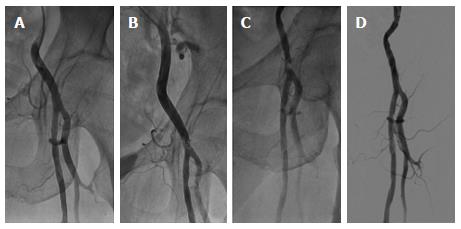Copyright
©2014 Baishideng Publishing Group Inc.
World J Cardiol. Aug 26, 2014; 6(8): 836-846
Published online Aug 26, 2014. doi: 10.4330/wjc.v6.i8.836
Published online Aug 26, 2014. doi: 10.4330/wjc.v6.i8.836
Figure 3 Post-transcatheter aortic valve implantation common femoral artery stenosis.
Standard angiography obtained before 18 F sheath insertion for transcatheter aortic valve implantation showed the absence of significant stenosis, tortuosity and calcification of left iliac-femoral artery (A); after vascular access closure by Prostar XL, angiography documented the presence of an intimal flap in the right common femoral artery (CFA) wall, not determining a significant flow limitation (B); 4-mo follow-up angiography showed progression of arterial damage and the development of significant stenosis of CFA, determining claudication (Fontaine-Leriche class IIb) (C); angioplasty of left CFA was performed by right transradial access, using a 125 cm 6 F Multipurpose guiding catheter and a 300 cm BMW Universal wire; a 4.0 mm x 15 mm non-compliant coronary balloon (NC Sprinter, Medtronic, North Carolina, United States) and a 6.0 mm x 20 mm peripheral balloon (Avion Plus, Invatec, Roncadelle, Italy) were inflated to 24 atm, obtaining an optimal final result (D).
- Citation: Dato I, Burzotta F, Trani C, Crea F, Ussia GP. Percutaneous management of vascular access in transfemoral transcatheter aortic valve implantation. World J Cardiol 2014; 6(8): 836-846
- URL: https://www.wjgnet.com/1949-8462/full/v6/i8/836.htm
- DOI: https://dx.doi.org/10.4330/wjc.v6.i8.836









